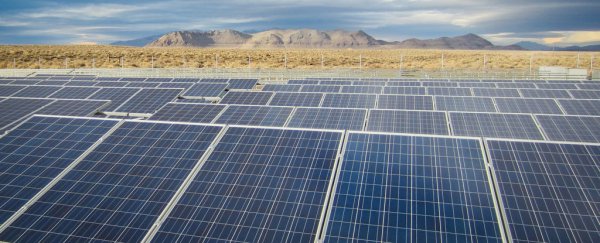Last year was an absolutely huge 12 months for renewable energy, with a new global status report on clean energy highlighting how 2015 was a record year for the industry – including the revelation that renewable energy can now satisfy nearly a quarter of the world's power demands.
According to energy policy network REN21, record clean energy investments in 2015 drove the largest annual increase ever in renewable power generating capacity, with an estimated 147 gigawatts (GW) added to the global grid – suggesting that by the end of 2015, renewable capacity could shoulder 23.7 percent of global electricity requirements.
"What is truly remarkable about these results is that they were achieved at a time when fossil fuel prices were at historic lows, and renewables remained at a significant disadvantage in terms of government subsidies," said REN21 executive secretary Christine Lins. "For every dollar spent boosting renewables, nearly 4 dollars were spent to maintain our dependence on fossil fuels."
Among new investments in the renewable power sector, wind and solar represented the majority of growth, accounting for about 77 percent of new installations, with hydropower taking up most of the rest. Jobs in renewable energy increased, and now employ some 8.1 million people across the world.
"As renewables secure record investments year after year, we are seeing that it is local governments, communities, and citizens who are the real pioneers of this transition to a world powered by 100 percent renewable energy," said senior program manager for climate energy, Anna Leidreiter, from the charity World Future Council. "Their support is logical really – renewable energy delivers impact locally and therefore most cities and communities see a huge benefit in investing in renewable sources to ensure that revenues stay in the region."
Overall, global investments in clean energy hit US$285.9 billion (not counting large-scale hydropower stations), topping 2014's $273 billion – a year in which 19.2 percent of the world's consumption of energy was provided by renewables.
China is driving this growth, accounting for more than one-third of global investments in renewable energy, with the US, Japan, the UK, and India rounding out the top five nations.
In terms of overall power capacity sourced from renewables, not including hydropower, China again leads, trailed by the US, Brazil, Germany, and Canada. But if you look at the capacity of renewable power per capita, the field looks pretty different: Denmark leads, then Germany, Sweden, Spain, and Portugal.
It's awesome to see renewable energy making such great strides, but the report's authors warn against becoming complacent, saying there are still significant barriers keeping clean energy from even faster adoption.
"The renewables train is barrelling down the tracks, but it's running on 20th century infrastructure – a system based on outdated thinking where conventional baseload is generated by fossil fuels and nuclear power," said chair of REN21, Arthouros Zervos. "To accelerate the transition to a healthier, more-secure, and climate-safe future, we need to build the equivalent of a high-speed rail network – a smarter, more flexible system that maximises the use of variable sources of renewable energy."
You can find out more about in the report and the state of renewable energy in 2016 in the video below:
